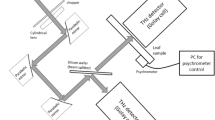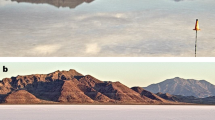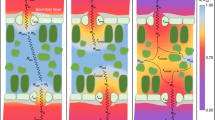Abstract
INCREASING use is being made of psychrometric methods of measuring vapour pressure in biological systems as a means of assessing the energy status of water in the system, using a small thermocouple as a psychrometer to measure relative humidity under constant temperature. The choice of equipment is obviously related to the use to which it is to be put, but for laboratory estimates of soil water potential the simplest equipment described to date is that of Monteith and Owen1. This method has been modified, by greatly reducing the size of both thermocouple and chamber, to ensure the rapid equilibration needed with plant tissue samples, and has then been used for making an assessment of the precision of measurements of leaf water potentials. Full details of the equipment used are given elsewhere2.
This is a preview of subscription content, access via your institution
Access options
Subscribe to this journal
Receive 51 print issues and online access
$199.00 per year
only $3.90 per issue
Buy this article
- Purchase on Springer Link
- Instant access to full article PDF
Prices may be subject to local taxes which are calculated during checkout
Similar content being viewed by others
References
Monteith, J. L., and Owen, P. C., J. Sci. Instrum., 35, 443 (1958).
Waister, P. D., Univ. of Nottingham, Dept. of Hort. Misc. Public., 15 (1963).
Ehlig, C. F., Plant Physiol., 37, 288 (1962).
Author information
Authors and Affiliations
Rights and permissions
About this article
Cite this article
WAISTER, P. Precision of Thermocouple Psychrometers for measuring Leaf Water Potential. Nature 205, 922–923 (1965). https://doi.org/10.1038/205922a0
Issue Date:
DOI: https://doi.org/10.1038/205922a0
This article is cited by
Comments
By submitting a comment you agree to abide by our Terms and Community Guidelines. If you find something abusive or that does not comply with our terms or guidelines please flag it as inappropriate.



